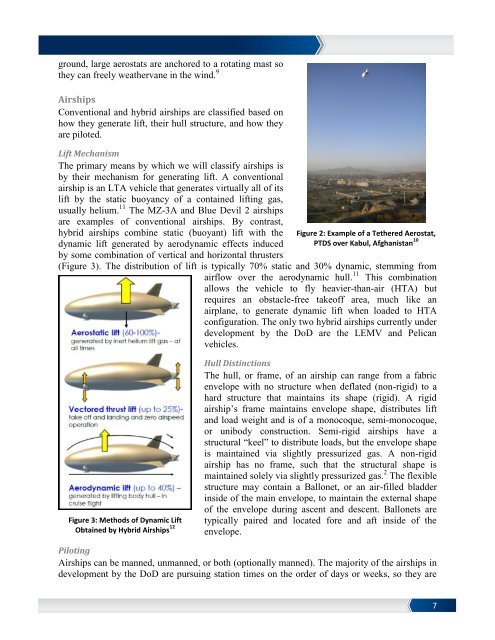lighter-than-air vehicles - Defense Innovation Marketplace
lighter-than-air vehicles - Defense Innovation Marketplace
lighter-than-air vehicles - Defense Innovation Marketplace
You also want an ePaper? Increase the reach of your titles
YUMPU automatically turns print PDFs into web optimized ePapers that Google loves.
ground, large aerostats are anchored to a rotating mast sothey can freely weathervane in the wind. 9AirshipsConventional and hybrid <strong>air</strong>ships are classified based onhow they generate lift, their hull structure, and how theyare piloted.Lift MechanismThe primary means by which we will classify <strong>air</strong>ships isby their mechanism for generating lift. A conventional<strong>air</strong>ship is an LTA vehicle that generates virtually all of itslift by the static buoyancy of a contained lifting gas,usually helium. 11 The MZ-3A and Blue Devil 2 <strong>air</strong>shipsare examples of conventional <strong>air</strong>ships. By contrast,hybrid <strong>air</strong>ships combine static (buoyant) lift with the Figure 2: Example of a Tethered Aerostat,dynamic lift generated by aerodynamic effects induced PTDS over Kabul, Afghanistan 10by some combination of vertical and horizontal thrusters(Figure 3). The distribution of lift is typically 70% static and 30% dynamic, stemming from<strong>air</strong>flow over the aerodynamic hull. 11 This combinationallows the vehicle to fly heavier-<strong>than</strong>-<strong>air</strong> (HTA) butrequires an obstacle-free takeoff area, much like an<strong>air</strong>plane, to generate dynamic lift when loaded to HTAconfiguration. The only two hybrid <strong>air</strong>ships currently underdevelopment by the DoD are the LEMV and Pelican<strong>vehicles</strong>.Figure 3: Methods of Dynamic LiftObtained by Hybrid Airships 12Hull DistinctionsThe hull, or frame, of an <strong>air</strong>ship can range from a fabricenvelope with no structure when deflated (non-rigid) to ahard structure that maintains its shape (rigid). A rigid<strong>air</strong>ship’s frame maintains envelope shape, distributes liftand load weight and is of a monocoque, semi-monocoque,or unibody construction. Semi-rigid <strong>air</strong>ships have astructural “keel” to distribute loads, but the envelope shapeis maintained via slightly pressurized gas. A non-rigid<strong>air</strong>ship has no frame, such that the structural shape ismaintained solely via slightly pressurized gas. 2 The flexiblestructure may contain a Ballonet, or an <strong>air</strong>-filled bladderinside of the main envelope, to maintain the external shapeof the envelope during ascent and descent. Ballonets aretypically p<strong>air</strong>ed and located fore and aft inside of theenvelope.PilotingAirships can be manned, unmanned, or both (optionally manned). The majority of the <strong>air</strong>ships indevelopment by the DoD are pursuing station times on the order of days or weeks, so they are7

















